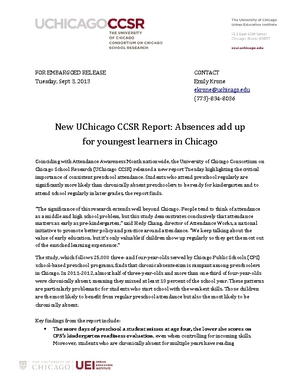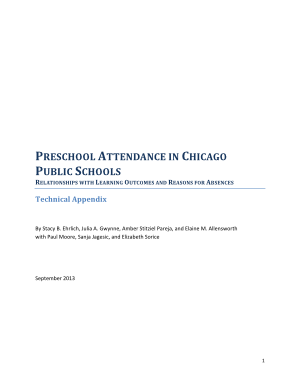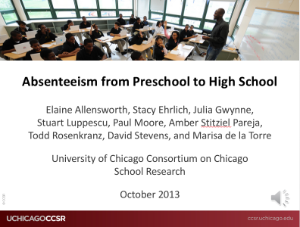1. What is the extent of absenteeism among preschool students?
2. Is preschool attendance tied to students’ academic success---both in preschool and beyond?
3. Why are students absent from preschool?
This report highlights the critical importance of consistent preschool attendance. Students who attend preschool regularly are significantly more likely than chronically absent preschoolers to be ready for kindergarten and to attend school regularly in later grades, the report finds.
“The significance of this research extends well beyond Chicago. People tend to think of attendance as a middle and high school problem, but this study demonstrates conclusively that attendance matters as early as pre-kindergarten,” said Hedy Chang, director of Attendance Works, a national initiative to promote better policy and practice around attendance. “We keep talking about the value of early education, but it’s only valuable if children show up regularly so they get the most out of the enriched learning experience.”
The study, which follows 25,000 three- and four-year-olds served by Chicago Public Schools (CPS) school-based preschool programs, finds that chronic absenteeism is rampant among preschoolers in Chicago. In 2011-2012, almost half of three-year-olds and more than one-third of four-year-olds were chronically absent, meaning they missed at least 10 percent of the school year.
These patterns are particularly problematic for students who start school with the weakest skills. Those children are the most likely to benefit from regular preschool attendance but also the most likely to be chronically absent.
Key findings from the report include:
- The more days of preschool a student misses at age four, the lower she scores on CPS’s kindergarten readiness evaluation, even when controlling for incoming skills. Moreover, students who are chronically absent for multiple years have reading performance levels at the end of second grade that are, on average, considered “at-risk” and in need of some level of intervention.
- Students who are chronically absent in preschool are five times more likely to be chronically absent in second grade. Chronic absenteeism in preschool establishes a pattern of inconsistent attendance that is often repeated in later grades. One-third of chronically absent four-year-olds go on to be chronically absent in kindergarten, compared with just 6 percent of students who were not chronically absent from preschool.
- African American children are almost twice as likely to be chronically absent as other students. Chronic absenteeism is also higher among students who live in high-poverty neighborhoods; however, even after taking into account neighborhood poverty, African American students are still much more likely to be chronically absent than students of any other race/ethnicity. African American students are absent more frequently because they are sick more often and because they face more logistical obstacles to getting to school.
- Sickness is the number one factor driving preschool absences. Logistical obstacles affecting families are the second largest factor. More than half of all preschool absences are due to children being sick. Another 18 percent are due to a range of logistical obstacles facing families, including transportation and childcare issues.
- Most parents with children enrolled in preschool believe attendance is important; however, those who believe that regular preschool attendance is as important as attendance in later grades have children with significantly better attendance.
“These findings are challenging because chronic absenteeism is so prevalent and the reasons preschoolers miss school are so diverse,” said report co-author Stacy Ehrlich. “However, there is also a clear opportunity to engage families and communities by addressing the issues that contribute to chronic absenteeism in preschool. Improving preschool attendance will require a student-by-student, family-by-family, school-by-school approach.”
A technical appendix for this report can be found here.
This report is the result of a collaboration between the UChicago Consortium and the Office of Early Childhood Education at Chicago Public Schools. It was generously funded by the McCormick Foundation.
Absenteeism from Preschool to High School - This PowerPoint is accompanied by a 37-minute audio presentation on attendance across several UChicago Consortium projects. To play the presentation, simply start the slideshow. Slides will change automatically.







